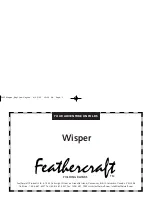
36
time the opening and closing of these plates cause the associated O-rings to wear-out. Replace
these o-rings as necessary to maintain the watertight integrity of the plates.
Batteries
The batteries in your boat has been selected to match the starting requirements of your engine.
Batteries are secured in non-metallic trays to avoid electrolyte spills. If the battery is not sealed,
fluid levels should be checked at least once a month. Fill the battery to the upper level with
distilled water. Never overfill a battery. Keep terminals clean by scrubbing them with a stiff brush
and a mixture of baking soda and water annually. Afterwards, apply a light coat of grease. The
mixture should not enter the battery. When the batteries are not in use check them each month
by using a battery hydrometer that measures the specific gravity. Batteries do not last forever
and will need to be replaced periodically. Life span will vary depending upon use and operating
locale, but two years is generally expected.
Electrical Connections
The wiring and electrical connections in a boat, especially those used in saltwater, are exposed
to a more corrosive environment than wiring in your car/truck. As a result, extra care must be
taken to promote long life of your electrical system. You should clean all connections thoroughly
immediately following each use and coat all connections in di-electric grease every six months.
Use of a salt inhibitor such as Salt-X or Salt Away is recommended as well. Finally, you must
remember that a boat takes much more abuse and shock than an automobile, so you must
constantly check and adjust the tightness of all electrical connections.
Fasteners
As just referenced above, a boat takes much more abuse and shock than an automobile. There
is no shock absorbers or suspension. As a consequence, screws, bolts, nuts and all other forms
of fasteners are subjected to significantly more stress. You MUST constantly check and adjust
the tightness of all fasteners.
BOAT STORAGE
General Information
Boats stored during the winter or for an extended period require routine maintenance. Prior to
and during the storage process the boat and its systems should be checked for maintenance
and repairs. It is recommended that you arrange these repairs during the storage period. Avoid
costly damage and delay when launching your boat by having it stored and winterized properly.
Lifting
To avoid personal injury and property damage it is advised to take extra precautions when lifting
or moving the boat for storage. Our boats are typically equipped with stern eyes and bow eyes
for trailering…not for lifting. For lifting, you must install lifting ring options that are suited for that
purpose. Rings and eyes should be inspected regularly to insure structural integrity. While
transporting a boat by lift or tow motor the structure should remain as close to ground level as
possible. If slings are necessary for lifting or transporting they should be in proper condition and
tied together to prevent any movement (separating or slipping) which could cause damage to
the boat. If tow motors are used to move the boat the forks should be padded and in a secure
location under the hull near the chine. The forks should be long enough to prevent the boat from
rocking forward and aft causing it to become unbalanced.
RIZATION AND STORAGE
Содержание Bohemian 17
Страница 1: ...1 OWNERS AND OPERATORS MANUAL...



































